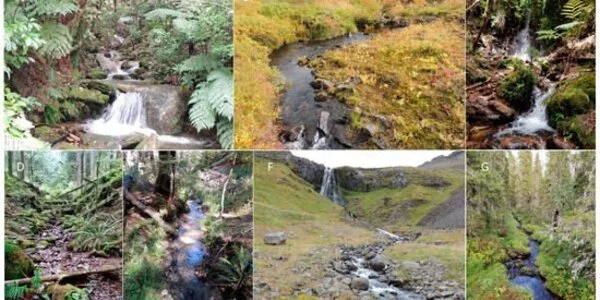Since the 1980s, land managers have spent millions of dollars each year to reintroduce large pieces of wood into streams, mostly for the sake of fish habitat. However, little is known about the effects of big timber in streams on birds and land-based animals.
Ezmie Trevarrow and Ivan Arismendi of Oregon State University are beginning to change that with a recently published paper in Biodiversity and Conservation that outlines what they observed from a year of footage from motion-triggered video cameras they set up near multiple large log jams in a creek just west of Corvallis.
“This study reveals a hidden role of large wood in streams,” said Trevarrow, who conducted the research as an undergraduate in the Honors College at Oregon State and is now a research associate at the University of Georgia. “The findings are valuable for land managers because they demonstrate additional value of restoration projects that involve wood placement into streams.”
This study reveals a hidden role of large wood in streams. The findings are valuable for land managers because they demonstrate the additional value of restoration projects that involve wood placement into streams.
Ezmie Trevarrow
In the paper, Trevarrow and Arismendi focused their attention on what species they saw, the most common observed activities, and the seasonality of the detections. Among their findings:
- During the study period, forty species were observed. Mule deer, raccoon belted kingfisher, Townsend’s chipmunk, deer mouse western grey squirrel, Virginia opossum, and American robin were among the most common species.
- The most prevalent animal activities near log jams were movement (68%), rest (18%), and food handling/eating (9%), implying that huge wood in streams works as lateral corridors, or motorways as Trevarrow described it, connecting terrestrial habitats for wildlife year-round.
- There is a pronounced seasonality in detections and species richness, with the highest values occurring in the summer and spring and the lowest values occurring in the winter. Summer, for example, saw the most species (27), followed by spring (23), fall (22), and winter (21).
Before the 1970s, land managers, recreationists, and the public considered large wood in rivers as undesirable, and the removal of wood from streams was extensively promoted across United States. Think of European settlers and images of clean, flat rivers, Arismendi said.

“There is a lot of cultural legacy there,” said Arismendi, an associate professor at the Department of Fisheries, Wildlife, and Conservation Sciences. “Log jams were considered as places that increased flood risk, hampered navigation and transport, and stored waste.”
However, scientific and management attitudes on big timber in streams have shifted. While the benefits of huge wood in streams for fish, particularly salmon, have been thoroughly documented, the Oregon State researchers say few studies have focused on the impact on land-based species.
For their study, they set up 13 cameras between June 2020 and June 2021 along Rock Creek, about 15 miles west of Corvallis. They collected 1,921 videos containing at least one animal detection, including some unexpected species and activities:
- A golden eagle is a species rarely seen in the region.
- Two mule deer are being swept away after attempting to climb onto a log during a high flow event.
- A deer mouse and raccoon separately crossed a log jam during high flow even where water covered the full length of the log.
This summer, Arismendi will expand the investigation to Oregon State’s H.J. Andrews Experimental Forest in the Cascade Mountains of Oregon, which has 30 motion-triggered camera sites. “This is the beginning of a more in-depth investigation of this topic,” Arismendi explained. “I believe there is much to be unpacked regarding the role of log jams in waterways.”
Trevarrow won an OSU Honors College Experiential Award, which helped pay for some of the research. The paper is part of her thesis study, which began when she volunteered at Arismendi’s lab at the College of Agricultural Sciences.
















